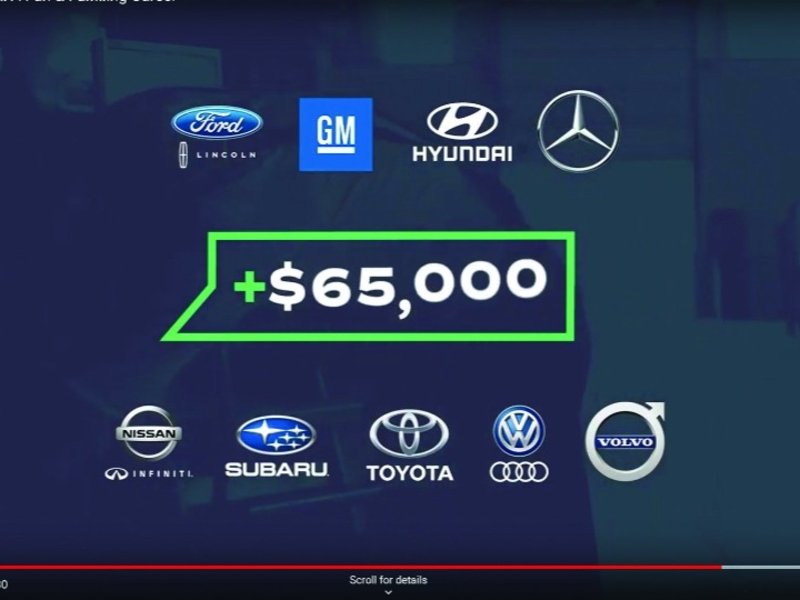
Most everyone agrees that a shortage of technicians ranks among the biggest challenges facing dealership service departments.
Over the decades, recruiting strategies have largely been aimed at high school and college-age students. Now, the latest in a long line of industry efforts is trying to lure them at an even younger age.
“We decided we would target as young as middle school,” said Harry Hollenberg, a managing director at Carlisle & Co., a Concord, Mass., consulting firm that has been working for the better part of a year with nine automakers (Ford, General Motors, Hyundai, Mercedes-Benz, Nissan, Subaru, Toyota, Volkswagen and Volvo) on the Auto Technician Collaborative.
The signature recruiting part of the program is called Project Shift. Its website attempts to hit all the right pre-teen and teenage angst buttons — or at least the buttons of parents.
Worried about the future? There will always be demand for service technicians.
Dread the prospect of a meaningless desk job? The best techs help people by finding answers to fresh challenges every day.
Not cut out for grease and grime? The auto shop is now a place for computers and high-tech tools.
Can’t wait to get out from under your parents’ roof? Auto techs can find jobs most anywhere.
There’s an attractive cost equation, too.
Consider the promise of good money following two years of post-high school training and a typical $20,000 investment in tuition.
Or add $100,000 and two more years to the education tab for a bachelor’s degree that likely doesn’t offer anything close to the job guarantee that technicians have.
“The No. 1 thing that every dealer says is, ‘I could use an extra technician or two,’ ” said Michelle Johnson, senior manager of technician development and recruitment at Nissan North America, one of the collaborative’s partners.
It’s not as if Nissan hasn’t been trying. Its Nissan Technician Training Academy, for example, partners with 22 community colleges that encourage students to seek apprentices at Nissan dealerships.
But there’s a need to go younger, Johnson admits. And perhaps a bigger need to target beyond the students themselves. Parents and school counselors also must be convinced that being an auto technician “is a viable, rewarding career,” she said.
In line with that thinking, the initial videos will be aimed at adults who are typing things such as “best job without a college degree” into their search engines, said Carlisle’s Hollenberg.
Subsequent videos, mainly 30-second spots, likely will target students.
The project also will address retention. That effort will zero in on that critical second year of the job.
“That’s where all the falloff is,” Hollenberg said.
Carlisle worked with some big dealership groups — Hendrick Automotive, Sonic Automotive and Sewell Automotive — to interview technicians and come up with some best practices for retention. The findings are packaged into a 72-page playbook.
Eric Kenar, a technical training manager at General Motors, said the collaborative came together at a good time for his company.
GM’s dealership techs, on average, are older than most, he said. That means its recruiting needs are going to be even more urgent.
Kenar also pointed to Carlisle’s retention book as a guide for hanging on to technicians far away from retirement.
“We are all getting together to do the right thing,” he said of his competitors. “We all have the same issue.”
In the realm of dealership culture, for example, the playbook lists public recognition for collaborating as a good practice. A best practice: giving employees financial rewards for stoking collaboration.
Carlisle also has developed a tool to calculate the cost of losing a technician. It will be shared with automakers in hopes it will filter down to the dealer level.
Factors in the formula include revenue lost when service bays go empty when a technician quits.
Also included is the cost of recruiting a replacement and the decline in productivity when a less-experienced tech replaces a veteran. Hollenberg said the tool is customizable to reflect unique circumstances inside a dealership.
When the costs are bundled together, the average dealership stands to lose $173,000 over 13 months when a newly minted technician replaces a veteran.
If that and other lessons from the Auto Technician Collaborative make a mark, dealers may have time to make their dealerships more attractive places for today’s seventh-graders to someday call their home away from home.